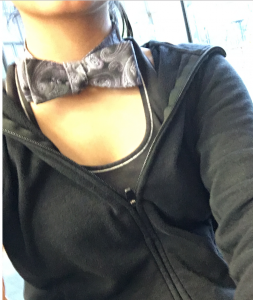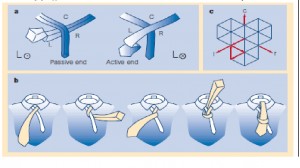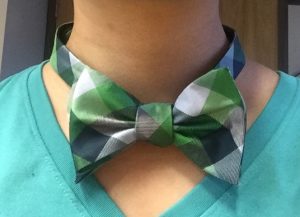For this event, GRF Tyler and SAs Ben and Ashley gave out a few pointers for looking good for different professional occasions. I typically tend to stay in the safe zone when it comes to any type of professional event, however, after this event I’m willing to experiment a little more. Even though you’re dressing professionally, it doesn’t mean you can’t show your personality! In addition to women’s pointers, Ty and Ben also covered professional attire for men. I’m was always confused as to what the proper attire for men is in different professional occasions, but after this event, I got a bit of a better grasp. with the help of Ty, we even learned how to tie ties and bow ties! Although I don’t plan on incorporating a bow tie/tie in my outfits anytime soon, learning how to a tie was useful considering my dad is always asking me to tie his–on the rare occasion that he does wear one. Considering I’ve never tied a bow tie/tie before, I think I did pretty well! Hopefully I can practice my tying skills sometimes soon. Thanks Ty! 
Category Archives: 27/April/2017 – Rose Seminar – What Not To Wear
The 85 Ways to Tie a Tie
Last week, I attended an event related to professional attire. One of the activities during the event was learning how to tie neckties and bow ties. Most of the attendees didn’t know how to do it. I was surprised to find out there are actually 85 ways to tie a tie! In the late 1990s, two researchers Thomas Fink and Yong Mao of Cambridge’s Cavendish Laboratory used mathematical modeling to discovered eighty five possible types of knots using a conventional type of tie. Tie knots can be described a s a sequence of five possible moves: left (L), center(C) right(R), into (i), out (o), and through the loop(T). A tie knot can be defined a s a sequence of moves using a combination of the 6 possible moves such as left in, left out, right in, right out, center in and center out. All knot sequences end with center out and alternate between in and out, all knots of odd numbers of moves begin with left out, and the even numbers of moves begin with left in. Therefore, the shape of a knot depends on the number of right, left and center moves. For instance, here is the step you need to follow if you are using the four-in –hand method knot:
- Bring the wide end to the left and either over or under the narrow and divide the space into right, left and center regions
- The knot is moved in half turns so that the direction alternates between out of and into the shirt.
- The wide end is then wrapped from the right (left) over the front to the left(right) underneath to the center
- Finally it is brought through (T) making the front loop as shown below
Enjoy practicing!
Tying Ties with Ty
Last week I attended the seminar series event in which we learned how to tie various ties. Coming into the seminar, I knew how to tie a standard tie, but what I didn’t know (and was always interesting in learning about) was how to tie a bow tie. First we discussed what was appropriate attire for various events, for example interviews or cocktail hours. One aspect about attire that stood out to me was the difference between the genders. After the presentation, i see why women might take so long to get ready. There are a lot of critical decisions that have to be made in order to meet the dress code for a given event. Guys have sort of a standard base in which they can base their outfit on (shirt and pants) while women, have to decide on whether or not a skirt is appropriate or what about a jacket, etc. Also, for guys it is easy to dress for events because we can always remove a tie or take off our jacket. If a woman picks the wrong piece of clothing, game over.
Because of this seminar, I have a new respect for people who wear bow-ties. Before this seminar, I always thought that people who wore a bow-tie were trying harder than they had too and that the bow-tie gave off a sense of a sense of arrogance like “Look at me, I’m wearing a bow-tie, I’m smarter than you.” After attempting to tie a bow-tie, there may be something to the arrogance. It is really hard to tie a bow-tie. Granted we didn’t have mirrors, but just trying to follow from the step-by-step instructions and even with help from Ty, it was tough.
Also, it was interesting to learn about the different variations of business casual. At my old school, business casual always meant jacket with tie optional depending on what the occasion was. In the seminar, there was a photo ranging from a guy wearing a polo and jeans to a guy with a sweater, jacket and tie all representing business casual. Regardless I definitely came out of that lecture with a better understanding of how to dress for success.
Interview Insider
So last week I had the privilege to attend a rose seminar on what not to wear to certain events: interviews, parties, information session, and work. Much to my surprise, there is a far thinner line for men to differentiate between business casual and business formal. Basically, if a man is wearing a matching suit, shoes that match his belt, a button down and a tie, this is considered business formal. The second the suit coat comes off, it’s business casual. Personally, I think it is nice that men can be flexible in terms of what they chose to wear for business casual attire: a blazer, a sweater, a button-down shirt with a bow tie, it looks like fun. It was also interesting to learn that people perceive ties as a more professional look compared to bow ties or collared shirts. Ultimately, however, the way one dresses to an interview, in the event they are unsure of what to wear, should give off a professional vibe, and then change if need be to fit the work environment.
The rule stands that it is always better to be overdressed than underdressed. After seeing what was appropriate for a woman to wear, I felt much more comfortable about the decisions I have made in terms of clothes I’ve worn to interviews and information sessions. Basically, girls should wear heels and either a matching skirt suit, pantsuit, or a dress with a nice blazer to be considered business formal. Personally, this is great for me because I love wearing heels and dresses because it gives off a very feminine aura. At the same time, however, it is important to take into account the work environment one is in and in certain more serious settings, a pantsuit is better suited for women to be accepted in the work force.
We ended the seminar by practicing how to tie a tie with Ty, a GRF in Flora Rose, which was fun but definitely showed me that I need to work on it much more before I can consider myself a pro. This seminar really helped, especially since I am entering my senior year and will begin applying for full-time jobs. And I have a new addition to my bucket list, learn how to tie an Eldredge knot.
Snappy Casual.
As a business major, we start the first day of school with learning what business professional, business casual, smart casual, and casual are. Every region of the country and even the world perceive it to be very different clothing. Although going into this workshop I didn’t think I would be learning new information, more so a refresher, this Rose event was probably my favorite.
Ty, the GRF leading this along with two SAs Liz and Ben, taught us how to neck tie AND a bow tie. The most ironic of this workshop was that most of the audience in attendance were women with only one man. Even though I would most likely never need to wear one in a professional setting, it was so much fun to learn. We learned how to tie a full windsor knot on the neck tie. It’s the classic full triangle knot and probably my favorite. Towards the end of the workshop, I was able to tie it pretty well!
The bow tie was definitely much more tricky. Not only is it shorter, there are a bunch of loops to be formed and all tightly against your neck. It can’t be scooted up like the neck tie. The trickiest part for me was the last step of pulling the second loop for form the bow tie. In the end, I finally got it and bragged about knowing how to tie a bow tie for the rest of the week.
I think the bow tie matches perfectly with my outfit. What do you think?


